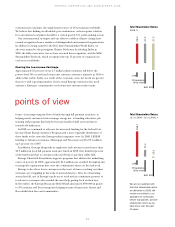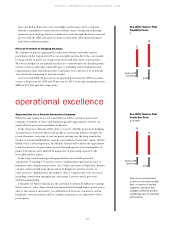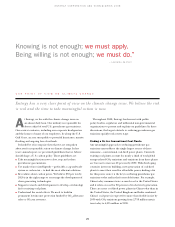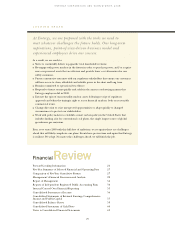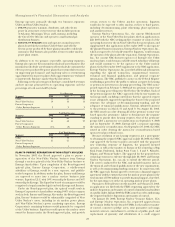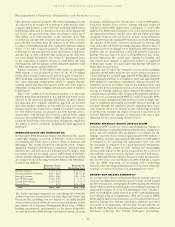Entergy 2008 Annual Report Download - page 23
Download and view the complete annual report
Please find page 23 of the 2008 Entergy annual report below. You can navigate through the pages in the report by either clicking on the pages listed below, or by using the keyword search tool below to find specific information within the annual report.
21
Knowing is not enough; we must apply.
Being willing is not enough; we must do.”
t Entergy, we live with the climate change issue on
an almost daily basis. Our industry is responsible for
about a third of total U.S. greenhouse gas emissions.
Our service territories, including our corporate headquarters
and the homes of many of our employees, lie along the U.S.
Gulf Coast, an area susceptible to powerful hurricanes, massive
flooding and ongoing loss of wetlands.
It should be of no surprise then that we are outspoken
advocates for responsible action on climate change. In last
year’s annual report, we presented guidelines that we believe
should shape a U.S. carbon policy. Those guidelines are:
n Take meaningful action now to slow, stop and reduce
greenhouse gas emissions.
n Use market forces intelligently – preferably a cap-and-trade
system or carbon tax – to find the most efficient solutions.
n Be realistic about carbon prices. We believe $50 per ton by
2020 is in the right range to encourage the development of
clean generating technologies.
n Support research and development to develop a technology
fix for existing coal plants.
n Understand the social effects. We need to build in
permanent low-income protection funded by CO2 allowance
sales or CO2 tax revenues.
Throughout 2008, Entergy leaders met with public
policy leaders, regulators and influential non-governmental
organizations to present and explain our guidelines. In these
discussions, the largest obstacle to reducing greenhouse gas
emissions quickly took center stage.
Finding a Fix for Conventional Coal Plants
Any meaningful approach to reducing greenhouse gas
emissions must address the single largest source of those
emissions – conventional coal-fired power plants. Currently,
existing coal plants account for nearly a third of total global
energy-related CO2 emissions and emissions from these plants
are forecast to increase 60 percent by 2030. With developing
countries intent on building a new generation of coal-fired
plants to meet their need for affordable power, finding a fix
for this power source is the key to reducing greenhouse gas
emissions today and in the foreseeable future. For example,
China today consumes twice as much coal as the United States
and it relies on coal for 80 percent of its electricity generation.
There are more coal-fired power plants in China today than in
the United States, the United Kingdom and India combined.
China’s coal power is expected to more than double in size by
2030 with CO2 emissions growing from 2,758 million metric
tons today to 6,055 million in 2030.
OUR POINT OF VIEW ON CLIMATE CHANGE
ENTERGY CORPORATION AND SUBSIDIARIES 2008
– Leonardo da Vinci
Entergy has a very clear point of view on the climate change issue. We believe the risk
is real and the time to take meaningful action is now.
A
21


